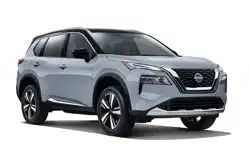Loading ...
Loading ...
Loading ...

(303,1)
system cannot detect all vehicles under all
conditions.
* The radar sensors may not be able to
detect and activate the Intelligent Blind
Spot Intervention when certain objects are
present such as:
— Pedestrians, bicycles, animals.
— Vehicles such as motorcycles, low
height vehicles, or high ground clear-
ance vehicles.
— Vehicles remaining in the detection
zone when you accelerate from a stop.
— Oncoming vehicles.
— A vehicle merging into an adjacent
lane at a speed approximately the
same as your vehicle.
— A vehicle approaching rapidly from
behind.
— A vehicle which your vehicle overtakes
rapidly.
— A vehicle that passes through the
detection zone quickly.
* The radar sensor’s detection zone is de-
signed based on a standard lane width.
When driving in a wider lane, the radar
sensors may not detect vehicles in an
adjacent lane. When driving in a narrow
lane, the radar sensors may detect vehicles
driving two lanes away.
* The radar sensors are designed to ignore
most stationary objects, however objects
such as guardrails, walls, foliage and
parked vehicles may occasionally be de-
tected. This is a normal operation condi-
tion.
* The following conditions may reduce the
ability of the radar to detect other vehicles:
— Severe weather
— Road spray
— Ice/frost/dirt build-up on the vehicle
* Do not attach stickers (including transpar-
ent material), install accessories or apply
additional paint near the radar sensors.
These conditions may reduce the ability of
the radar to detect other vehicles.
* The camera may not detect lane markers
in the following situations and the Intelli-
gent Blind Spot Intervention system may
not operate properly.
— On roads where there are multiple
parallel lane markers; lane markers
that are faded or not painted clearly;
yellow painted lane markers; nonstan-
dard lane markers; lane markers cov-
ered with water, dirt, snow, etc.
— On roads where discontinued lane
markers are still detectable.
— On roads where there are sharp
curves.
— On roads where there are sharply
contrasting objects, such as shadows,
snow, water, wheel ruts, seams or lines
remaining after road repairs.
— On roads where the travelling lane
merges or separates.
— When the vehicle’s travelling direction
does not align with the lane markers.
— When travelling close to the vehicle in
front of you, which obstructs the lane
camera unit detection range.
— When rain, snow or dirt adheres to the
windscreen in front of a lane camera
unit.
— When the headlights are not bright
due to dirt on the lens or if aiming is
not adjusted properly.
— When strong light enters a lane cam-
era unit. (For example: light directly
shines on the front of the vehicle at
sunrise or sunset.)
— When a sudden change in brightness
occurs. (For example: when the vehicle
enters or exits a tunnel or under a
bridge.)
* Do not use the Intelligent Blind Spot Inter-
vention system under the following condi-
tions because the system may not function
properly.
— During bad weather. (For example:
rain, fog, snow, etc.)
— When driving on slippery roads, such
as on ice or snow, etc.
— When driving on winding or uneven
roads.
Starting and driving 299
Loading ...
Loading ...
Loading ...
